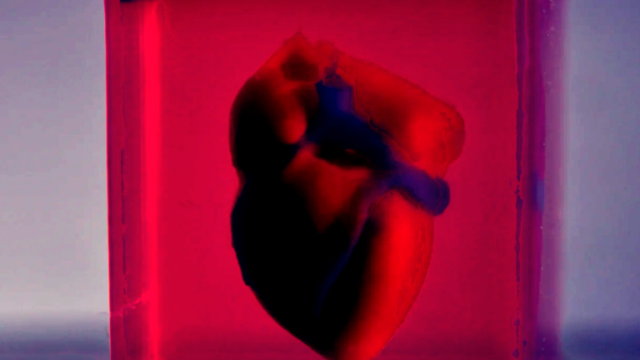Researchers have created first ever 3D-printed heart. The future is fucking wild, dudes.

Researchers have created a 3D-printed heart, my friends. Like, with blood vessels and shit. The future is absolutely wild. And while the heart they printed is about the size of a rabbit’s heart, it portends well for future development.
Bloomberg:
Israeli researchers have printed a 3D heart using a patient’s own cells, something they say could be used to patch diseased hearts — and possibly, for full transplants.
The heart the Tel Aviv University team printed in about three hours is too small for humans — about 2.5 centimeters, or the size of a rabbit’s heart. But it’s the first to be printed with all blood vessels, ventricles and chambers, using an ink made from the patient’s own biological materials.
“It’s completely biocompatible and matches the patient,” reducing the chances of rejection inside the body, said Tal Dvir, the professor who directed the project.
Researchers took fatty tissue from a patient, then separated it into cellular and non-cellular components. The cells were then “reprogrammed” to become stem cells, which turned into heart cells. The non-cellular materials were turned into a gel that served as the bio-ink for printing, Dvir explained.
Previously, only simple tissues — without the blood vessels they need to live and function — had been printed, according to a press release from the university. The breakthrough was reported Monday in a paper in Advanced Science.
Personalized Organs
“Patients will no longer have to wait for transplants or take medications to prevent their rejection,” the press release said. “Instead, the needed organs will be printed, fully personalized for every patient.”In a room off a warren of laboratories, a massive 3D printer sent a thin stream of “bio-ink” into a small square container. Inside sat a small heart the size and color of several pencil erasers.
The cells need to mature for another month or so and then should be able to beat and contract, Dvir said. The printed hearts could be tested on animals but there’s no timetable for testing hearts on humans, he said.
A human-sized heart might take a whole day to print and would require billions of cells, compared to the millions used to print these mini-hearts, Dvir said.
While it’s not clear a printer can produce hearts that are superior to human ones, “perhaps by printing patches we can improve or take out diseased areas in the heart and replace them with something that works” perfectly, he said.



